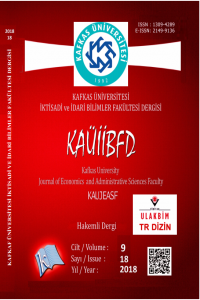TÜRKİYE İLE BRICS ÜLKELERİ ARASINDAKİ DIŞ TİCARET POTANSİYELİNİN LİNDER HİPOTEZİ ÇERÇEVESİNDE DEĞERLENDİRİLMESİ
Abstract
Bu çalışmanın amacı, 1996 – 2016
döneminde Türkiye’nin BRICS ülkeleri (Brezilya, Rusya, Hindistan, Çin ve Güney
Afrika) ile yaptığı ihracat ve ithalatta Linder hipotezinin geçerliliğini araştırmaktır.
Söz
konusu amaç doğrultusunda ihracat ve ithalatın bağımlı değişken olarak alındığı
iki model, ülkeler ve firmalar gibi çeşitli kesit verilerin belirli bir zaman
aralığı içinde bir araya getirilmesine imkan veren panel veri analizi
kullanılarak ampirik olarak sınanmıştır.
Çalışma sonucunda elde
edilen bulgulara göre, Türkiye ile BRICS ülkeleri arasında ihracat açısından Linder
hipotezi geçerlidir. Buna göre, Türkiye ile BRICS ülkelerinin kişi başına düşen
GSMH düzeyleri arasındaki fark azaldıkça Türkiye’nin bu ülkelere
yaptığı ihracat artmaktadır. Bir başka ifadeyle, Türkiye ile ticaret ortakları
olan BRICS ülkelerinin kişi başına düşen GSMH’ları arasındaki farkın %1 azalması,
Türkiye’nin ihracatını % 0.09 oranında artırmaktadır. Bu durum Türkiye ile
BRICS ülkeleri arasındaki ticaretin endüstriler arası olduğunu göstermektedir. Ayrıca
BRICS ülkelerinin GSMH’larında meydana gelecek %1’lik bir artış ise Türkiye’nin
ihracatını % 2.867 oranında artırmaktadır. Diğer yandan yine çalışmadan elde
edilen sonuçlara göre, Türkiye
ile BRICS ülkeleri arasında ithalat açısından Linder hipotezi geçerli değildir.
Keywords
References
- Ali Shah Bukhari, S.A.H., Ahmad, M.H., Alam, S., Ali Shah Bukhari, S.S.H. & Butt, M.S. (2005). An Empirical Analysis of The Linder Theory of International Trade for South Asian Countries, Pakistan Development Review, 44 (3), 307-320.
- Aliyu, S.U.R. & Bawa, S. (2015). Gravity Model By Panel Data Approach: Empirical Evidence from Nigeria, International Journal of Trade and Global Markets, 8 (1), 42-57.
- Arnon, A. & Weinblatt, J. (1998). Linder's Hypothesis Revisited: İncome Similarity Effects For Low İncome Countries, Applied Economics Letters, 5 (10), 607-611.
- Asteriou, D. & Hall, S. G. (2011). Applied Econometrics, Second Edition, London: Palgrave.
- Baltagi, B.H., Egger, P. & Pfaffermayr, M. A (2003). Generalized Design for Bilateral Trade Flow Models, Economics Letters, 80 (3), 391-397.
- Bergstrand, J. H. (1990). The Heckscher-Ohlin-Samuelson Model, The Linder Hypothesis And The Determinants of Bilateral İntra-İndustry Trade, The Economic Journal, 100(403), 1216-1229.
- Choi, C. (2002). Linder Hypothesis Revisited, Applied Economics Letters, 9 (9), 601-605.
- Chow, P., Kellman, M. & Shachmurove, Y. (1994). East Asian NIC Manufactured Intra-Industry Trade 1965-1990, Journal of Asian Economics, 5 (3), 335-348.
- Chow, P. & Yochanan, M. K. (1999). A Test of The Linder Hypothesis In Pacific NIC Trade 1965-1990, Applied Economics, 31 (2), 175-182.
- Francois, J.F. & Kaplan, S. (1996). Aggregate Demand Shifts, Income Distribution, and The Linder Hypothesis, Review of Economics and Statistics, 78 (2), 244-250.
- Gujarati, D. N. & Porter, D. C. (2009). Basic Econometrics, New-York: McGraw-Hill.
- Heckscher, E. F. & Ohlin, B. G. (1991). Heckscher-Ohlin Trade Theory, The MIT Press.
- Hill, R. C., Griffiths, W. E. & Lim, G. C. (2012). Principles of Econometrics, Fourth Edition, New York: John Wiley & Sons, Inc.
- Keum, K. (2010). Tourism Flows And Trade Theory: A Panel Data Analysis With The Gravity Model, Annals of Regional Science, 44 (3), 541-557.
- Kumar Mishra, A., Gadhia, J.N., Kubendran N. & Sahoo, M. (2015). Trade Flows Between India And Other BRICS Countries: An Empirical Analysis Using Gravity Model, Global Business Review, 16 (1), 107–122.
- Kundu, N. (2015). Bilateral Trade Balance of Bangladesh with BRICS Countries: A Static Panel Data Approach., Journal of Economics and Development, 17(2), 53–68.
- Linder, S. B. (1961). An Essay on Trade and Transformation (pp. 82-109). Stockholm: Almqvist & Wiksell.
- Mcpherson, M.A., Redfearn, M.R. & Tieslau, M.A. (2001). International Trade and Developing Countries: An Empirical Investigation of The Linder Hypothesis, Applied Economics, 33(5), 649-657.
- Sağlam, G. & Seymen, D. (2016). Türkiye’nin Dış Ticaretinin Talep Yönlü Analizi: Linder Hipotezinin Testi (1998-2012), Türkiye Ekonomi Kurumu Uluslararası Ekonomi Konferansı, UEK-TEK 2016, 502-533.
- Saygılı, F. & Manavgat, G. (2014). Linder Hipotezi: Türkiye'nin Dis Ticareti için Ampirik Bir Analiz/Linder Hypothesis: An Empirical Analysis on Turkey's Foreign Trade, Ege Akademik Bakis, 14(2), 261.
- Tatlıcı, Ö. & Kızıltan, A. (2011). Çekim Modeli: Türkiye’nin İhracatı Üzerine Bir Uygulama. Atatürk Üniversitesi İktisadi ve İdari Bilimler Dergisi, Ekonometri ve İstatistik Sempozyumu Özel Sayısı, 28-289.
- Thursby, J. G. & Thursby, M. C. (1987). Bilateral Trade Flows, The Linder Hypothesis, and Exchange Risk. The Review of Economics and Statistics, 488-495.TÜİK, Temel İstatistikler, http://www.tuik.gov.tr/UstMenu.do?metod=temelist
- WorldBank, World Development Indicators, http://databank.worldbank.org/data/reports.aspx?source=world-development-indicators
Details
| Primary Language | Turkish |
|---|---|
| Journal Section | Articles |
| Authors | |
| Publication Date | December 29, 2018 |
| Published in Issue | Year 2018 Volume: 9 Issue: 18 |
KAUJEASF is the corporate journal of Kafkas University, Faculty of Economics and Administrative Sciences Journal Publishing.
KAUJEASF has been included in Web of Science since 2022 and started to be indexed in the Emerging Sources Citation Index (ESCI ), a Clarivate product.

